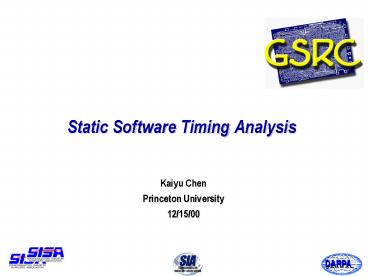Static Software Timing Analysis - PowerPoint PPT Presentation
1 / 15
Title:
Static Software Timing Analysis
Description:
Output annotated info. Determine block costs. Perform cache analysis ... l-block definition: a contiguous sequence of instructions within the same basic ... – PowerPoint PPT presentation
Number of Views:23
Avg rating:3.0/5.0
Title: Static Software Timing Analysis
1
Static Software Timing Analysis
- Kaiyu Chen
- Princeton University
- 12/15/00
2
Problem Overview
- Definition
- Static analysis techniques that predict timing
metrics (e.g. WCET/BCET, basic block execution
counts) for software running on certain processor - Only use information collected at or before
compile time - Restrictions
- Must be statically decidable (e.g. no infinite
loops) - Assume no interrupt or preemption
- Compared to on-the-fly (simulation) techniques
- Fast and low overhead
- Situations where impossible to simulate all
traces - May benefit from information collected by
compiler
3
Application Scenarios
Static Timing Analysis
4
A General Solution Framework
5
On-going work
- Our goal
- A retargetable performance estimation tool that
provides tight bounds for software performance in
MESCAL - Integrate Cinderella with Mescal Research Flow
- Replace Object file module and Instruction module
with preprocessor that parse and extract all
needed information from Mescal x-code compiler. - Derive basic block cost coefficients from
instruction schedule information (for classic
VLIW machine) or link with Mescal x-code
simulator to model other architectures.
6
Overview of Cinderella
- A self-consistent, retargetable static timing
analysis tool for embedded software. - Handle Program path analysis and
Micro-architecture with a single uniform ILP
based bounding technique - Currently provide back-end support for Intel i960
and Motorola M68000 chip with dedicated
Instruction cache.
7
Block diagram
8
Operation flow chart
9
Flow analysis example
10
Solution Strategies
- Cache analysis
- l-block definition a contiguous sequence of
instructions within the same basic block that are
mapped to the same cache set, and thus have
identical hit/miss behavior - Cache behavior are captured by constructing cache
conflict graph/ cache state transition graph,
assigning variables to model its structure and
associating them with flow analysis constraints - ILP problem formulation
- Object function
- Total execution time ? Ci Xi
- With cache analysis
- ?i ?j (Ci.jhit Xi.jhit Ci.jmiss Xi.jmiss)
11
Cache analysis example
Constraints p(s, 4.1) p(s, 7.1) p(s, e) 1
p(s, 7.1) p(4.1, 7.1) ? x5 x4 p(s,4.1)
p(4.1,4.1) p(7.1,4.1) p(4.1,e) p(4.1,4.1)
p(4.1,7.1) p(4.1,4.1) ? x4hit ? p(s,4.1)
p(4.1,4.1) x4hit x4miss x4
12
Integrated Flow Chart
13
Characteristics
- Efficient
- Fast problem solution through IPET options
available to allow tradeoff between speed and
accuracy - Accurate
- Provides safe and tight WCET/BCET bounds
- Modular
- Consists of clearly defined functional
components clean interface written in C for
extensibility - Retargetable
- Target independent analysis core with flexible
back-end support integrated in our retargetable
software development environment
14
Future work
- Improvement on Cinderella
- Profile to obtain static known path information
- extend instruction semantics to deal with unknown
data - Use better model to capture the interaction
between successive basic blocks - e.g. gain modeling assign a gain value to each
edge - Take advantage of compiler data flow analysis and
control flow analysis results - e.g. loop bounds, mutual exclusive path detection
15
Future work
- Handle other execution time dominating features
in modern architecture - More ILP predicated execution
- Treat Hyper-block as multiple concatenating basic
blocks - Predicate relationship can be obtained from BDD
package - Cache analysis data cache, multi-level cache
- Hierarchical CCG/CSTG for multi-level cache
- Static analysis of branch prediction
- Static prediction vs. dynamic prediction scheme































